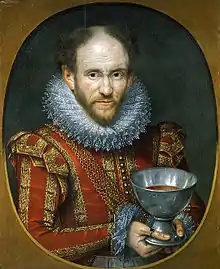Tom Durie
Tom Durie, Duri, Dury or Derry ( fl. 1600-1620) was a Scottish fool or entertainer to Anne of Denmark.

Career
Tom Durie appears on record at the Scottish court in May 1603, when he was bought clothes to accompany Anne of Denmark on her journey to England after the Union of the Crowns.[1] They included "green cloth to be ane coit to Thomas Durie hir Majesteis fule."[2]
The queen had his portrait painted in 1614 by Marcus Gheeraerts the Younger, and again by Paul van Somer, recorded in an inventory as the picture of "Tome Derey at Length".[3] Gheeraerts's painting is displayed at the National Gallery of Scotland. At Denmark House in London his portrait was displayed in an antechamber or passage between the queen's withdrawing room and the gallery and was recorded in an inventory as the picture of "Thomas Derry" in 1619.[4] Anne of Denmark also displayed his portrait at Oatlands.[5] In the 1630s the Gheeraerts painting was in the Queen's Gallery at Greenwich, with portraits of Anne's Danish relatives.[6]
Another fool at court, Archibald Armstrong, wore a crimson velvet coat with gold lace at the wedding of Princess Elizabeth and Frederick V of the Palatinate in 1613. The costume may have been like that in the portrait of Tom Durie.[7]
In June 1619, a horse described as a "grey nag" was bought for Tom Durie, costing £12.[8] A list of the horses of royal servants made in 1618 includes horses for Archie, Thom. Derry, and John Mawre, his keeper.[9]
King James used to call Robert Cecil, 1st Earl of Salisbury "my little beagle" or "young Tom Durie".[10] Salisbury once wrote a letter of apology to Adam Newton for a breach of manners, saying that "had I done so because I knew it not to be my duty, then am I worse than Tom Dyrry", suggesting that Durie did not adhere to court etiquette.[11] He compared himself to Tom Durie in another humorous letter to Newton, writing that if a supplicant failed to gain a place in Prince Henry's household, the man should be sent to "Tom Dyrry or to me".[12] Robert Cecil was short in height and courtiers made jokes about his stature.[13]
After the queen's death, one of her longserving Danish or German courtiers, William Belo, complained that he had been poorly rewarded for his service and paid less than Tom Durie, who was "a natural fool", or Archie Armstrong, "a counterfeit".[14] Belo had been expensive clothes to wear as a young man or teenager at the Scottish court, and may have been of small stature.[15] The subsidy accounts mention that a "littil Duchman" at court was given a diamond ring.[16]
.jpg.webp)
Tom was still alive in 1620 when an account mentions a payment of 9s-6d weekly for his food and lodging.[17] Some receipts for his and Archy Armstrong's costumes are kept with the papers of Lionel Cranfield at Kent History and Library Centre.[18]
References
- Michael Pearce, 'Anna of Denmark: Fashioning a Danish Court in Scotland', The Court Historian, 24:2 (2019), pp. 145-6.
- Letters to King James the Sixth from the Queen, Prince Henry, Prince Charles (Edinburgh, 1835), p. lxxxvii: National Records of Scotland, E21/76 p. 551.
- Karen Hearn, Dynasties: Painting in Tudor and Jacobean England, 1530-1630 (London, 1995), p. 194.
- M. T. W. Payne, 'An Inventory of Denmark House in 1619', Journal of the History of Collections, 13:1 (2001), p. 39.
- Jemma Field, Anna of Denmark: The Material and Visual Culture of the Stuart Courts (Manchester, 2020), p. 97.
- Oliver Millar, ‘The Inventories and Valuations of the King’s Goods 1649-1651’, The Volume of the Walpole Society, vol. 43 (1971-2), pp. 67, 316; ‘Abraham van der Doort’s Catalogue of the Collection of Charles I’, The Volume of the Walpole Society, vol. 37 (1958-9), p. 197.
- Frederic Madden, 'Warrant for the Apparel for the Marriage of the Princess Elizabeth', Archaeologia, 26 (1836), p. 392.
- Frederic Madden, Issues of the Exchequer (London, 1836), p. 316.
- HMC 6th Report: Graham (London, 1877), p. 326 the list of horses is now in the British Library.
- Karen Hearn, Dynasties: Painting in Tudor and Jacobean England, 1530-1630 (London, 1995), p. 194.
- Henry Ellis, Original Letters Illustrative of English History, 3rd Series, vol. 4 (London, 1846), p. 163 modernised here.
- Thomas Birch, Life of Henry Prince of Wales (London, 1760), p. 138
- Janet Dickinson, Court Politics and the Earl of Essex, 1589-1601 (Routledge, 2016), p. 103: HMC Salisbury, vol. 5 (London, 1894), pp. 97-8.
- Calendar State Papers Domestic Charles I, 1625, 1626 (London, 1858), p. 526.
- Michael Pearce, 'Anna of Denmark: Fashioning a Danish Court in Scotland', The Court Historian, 24:2 (2019), p. 145.
- Miles Kerr-Peterson & Michael Pearce, 'James VI's English Subsidy and Danish Dowry Accounts', Scottish History Society Miscellany XVI (Woodbridge, 2020), p. 85.
- HMC 4th Report: De La Warr (London, 1874), p. 282.
- Kent Archives, Cranfield's accounts